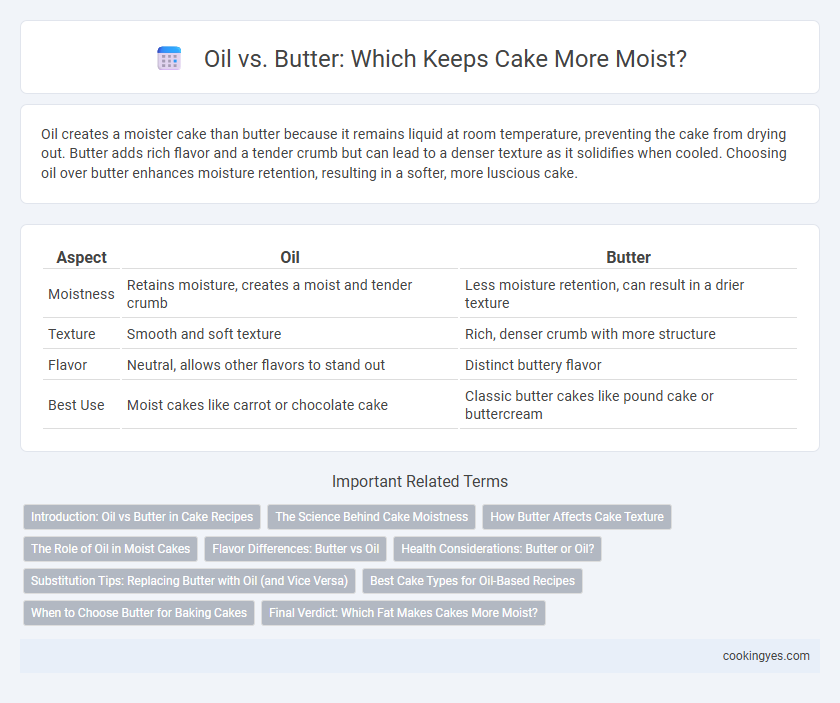Oil creates a moister cake than butter because it remains liquid at room temperature, preventing the cake from drying out. Butter adds rich flavor and a tender crumb but can lead to a denser texture as it solidifies when cooled. Choosing oil over butter enhances moisture retention, resulting in a softer, more luscious cake.
Table of Comparison
| Aspect | Oil | Butter |
|---|---|---|
| Moistness | Retains moisture, creates a moist and tender crumb | Less moisture retention, can result in a drier texture |
| Texture | Smooth and soft texture | Rich, denser crumb with more structure |
| Flavor | Neutral, allows other flavors to stand out | Distinct buttery flavor |
| Best Use | Moist cakes like carrot or chocolate cake | Classic butter cakes like pound cake or buttercream |
Introduction: Oil vs Butter in Cake Recipes
Oil retains moisture better than butter in cakes due to its liquid form at room temperature, resulting in a tender, moist crumb. Butter adds rich flavor and creates a firmer texture because it solidifies when cooled, enhancing cake structure. Choosing between oil and butter depends on desired cake texture and flavor intensity, with oil favored for softness and butter for flavor depth.
The Science Behind Cake Moistness
Oil retains moisture better than butter due to its liquid state at room temperature, preventing the cake from drying out as it cools. Butter contains water and milk solids that evaporate during baking, which can lead to a drier texture. The triglycerides in oil coat flour proteins more effectively, inhibiting gluten formation and resulting in a tender, moist crumb.
How Butter Affects Cake Texture
Butter contributes to a rich, tender crumb and enhances cake flavor through its fat content, which coats flour proteins and limits gluten formation, resulting in a softer texture. Its water content also creates steam during baking, aiding in leavening and moisture retention. Unlike oil, butter solidifies when cooled, producing a firmer yet moist crumb that is desirable in many cake varieties.
The Role of Oil in Moist Cakes
Oil plays a crucial role in creating moist cakes due to its liquid nature, which coats flour proteins more effectively than butter, preventing excessive gluten formation and resulting in a tender crumb. Unlike butter, which contains water that evaporates during baking and can dry out a cake, oil remains liquid at room temperature, helping cakes retain moisture longer. This ability to maintain moisture makes oil-based cakes especially soft and moist for extended periods.
Flavor Differences: Butter vs Oil
Butter imparts a rich, creamy flavor and contributes to a denser, more tender crumb in cakes, enhancing overall taste complexity. Oil, being flavor-neutral, creates a lighter texture and allows added ingredients like vanilla or fruit extracts to stand out more prominently. Choosing between butter and oil affects cake moistness and flavor profile, with butter adding depth and oil maintaining subtlety.
Health Considerations: Butter or Oil?
Choosing between oil and butter for cake moistness significantly impacts health profiles; oil, particularly vegetable or olive oil, contains healthier unsaturated fats that support heart health, while butter is rich in saturated fats and cholesterol, which may increase cardiovascular risk. Oils tend to increase overall moisture retention in the cake crumb, resulting in a softer texture without added trans fats, unlike some solid fats. Opting for oils derived from nuts or seeds can also add beneficial nutrients such as vitamin E and omega-3 fatty acids, enhancing the nutritional value of baked goods.
Substitution Tips: Replacing Butter with Oil (and Vice Versa)
Oil tends to create a moister and denser cake compared to butter, which adds a richer flavor and slightly firmer texture. When substituting butter with oil, use about 20% less oil than the butter called for, and reduce other liquids slightly to maintain batter consistency. Replacing oil with butter requires adding extra moisture, such as milk or sour cream, to prevent dryness while preserving flavor.
Best Cake Types for Oil-Based Recipes
Oil-based cakes, such as carrot cake, red velvet, and chocolate sheet cakes, retain moisture more effectively due to the liquid fat content that remains tender even after baking. Oil helps create a denser, softer crumb compared to butter, making it ideal for recipes requiring extended freshness or a more moist texture. Cakes requiring a delicate crumb and rich, moist flavor benefit most from oil-based recipes, enhancing overall softness and shelf life.
When to Choose Butter for Baking Cakes
Choose butter for baking cakes when rich flavor and tender crumb are desired, as butter enhances taste and texture through its natural milk solids and fat content. Butter's ability to trap air when creamed with sugar improves cake rise and creates a moist crumb, ideal for layered and pound cakes. Opt for butter in recipes where flavor depth and moisture retention from natural fats outweigh the lighter texture provided by oil.
Final Verdict: Which Fat Makes Cakes More Moist?
Butter provides rich flavor and a tender crumb, but oil yields a moister cake due to its liquid state at room temperature, helping retain moisture effectively. Cakes made with oil maintain softness longer, preventing dryness and staling compared to those made with butter. For maximizing cake moistness, using oil as the fat source is the superior choice.
Oil vs Butter for cake moistness Infographic

 cookingyes.com
cookingyes.com